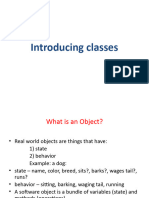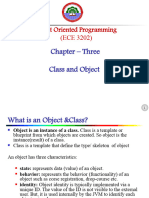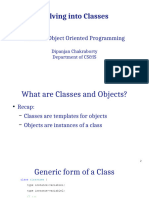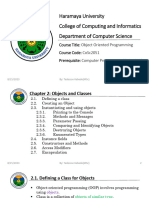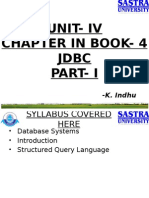UNIT- I
CHAPTER IN BOOK- 6
CLASSES & METHODS
-K. Indhu
�SYLLABUS COVERED HERE
Introducing Classes and Methods in
Java
K. INDHU
�GOALS
1. Introduction
2. Syntax for Class & Example for Class
3. Example for Class with Two Objects
4. Declaring Objects Syntax
5. Use of new Operator
6. Assigning Object Reference Variables
7. Methods Syntax & Example
8. Constructors Definition & Example
9. Three types of Constructors
10.Parameterized Constructors
11.This Keyword
12.Garbage Collection in Java Runtime Environment
13.Finalize() method
14.Stack Class Example with Output
K. INDHU
�INTRODUCTION
The class is at the core of Java.
It is the logical construct upon which the entire Java
language is built because it defines the shape and
nature (or template) of an object.
Any concept we wish to implement in a Java program
must be encapsulated within a class.
DEFINITION:1. A class is a template for an object.
2. In other words, a Class is a group of objects belonging
to similar kind.
K. INDHU
�SYNTAX FOR CLASS
K. INDHU
�EXAMPLE FOR CLASS
K. INDHU
�EXAMPLE FOR CLASS WITH 2
OBJECTS
K. INDHU
�DECLARING OBJECTS SYNTAX
K. INDHU
�USE OF NEW OPERATOR
The "new" operator dynamically allocates memory for an
object.
It has this general form:class-variable = new classname( );
Here, class-variable is a variable of the class type being
created.
The classname is the name of the class that is being
instantiated.
The class name followed by parentheses specifies the
constructor for the class.
A constructor initializes class members, when an object of a
class is created.
However, if no explicit constructor is specified, then Java will
automatically supply a default constructor.
K. INDHU
�ASSIGNING OBJECT
REFERENCE VARS.
K. INDHU
10
�METHODS SYNTAX
K. INDHU
11
�METHODS EXAMPLE
CLASSS FIELD DECLARATIO
METHOD RETURNING DOU
METHOD WITHOUT
RETURN VALUE
K. INDHU
12
�METHODS EXAMPLE
CONTINUED
CREATE 2 OBJECTS
CALL FUNCTION
WITHOUT
RETURN VALUE
CALL FUNCTION
WITH RETURN
VALUE DOUBLE
K. INDHU
13
CONSTRUCTORS
DEFINITION:Constructors is a SPECIAL FUNCTION->
-> which has same name as that of its class
name and,
-> that do not have return type.
PURPOSE OF CONSTRUCTOR:It can be tedious to initialize all of the
variables in a class each time an instance is
created.
A constructor initializes an object immediately
upon creation.
K. INDHU
14
�CONSTRUCTORS EXAMPLE
CONSTRUCTOR NAMED BOX IS WRITTE
new ClassName() automatically invokes
Constructor with no parameters
K. INDHU
15
�THREE TYPES OF
(1) DEFAULTCONSTRUCTORS
CONSTRUCTOR->
CONSTRUCTOR WITH NO PARAMETERS
(2) PARAMETERIZED CONSTRUCTOR->
CONSTRUCTOR WITH ONE OR MORE PARAMETERS
HERE, VALUES PASSED THRU PARAMETERS ARE
ASSIGNED TO THE MEMBERS OF THE CLASS.
IF PARAMETER NAME IS EQUAL TO CLASS MEMBER
NAME, THEN USE THIS POINTER TO ACCESS MEMBER
OF CLASS.
(3) COPY CONSTRUCTOR->
COPY CONSTRUCTOR IS NOT THERE IN JAVA LIKE IN C+
+.
BUT, USING PARAMETERIZED CONSTRUCTOR, OBJECT
CAN BE PASSED AS PARAMETER TO JAVA METHOD.
IN THIS WAY ONE OBJECT CAN BE COPIED TO ANOTHER
OBJECT.
K. INDHU
16
�PARAMETRIZED
CONSTRUCTORS
CONSTRUCTOR WITH THREE PARAM
K. INDHU
17
�THIS KEYWORD
That is, This is always a reference to the object on
which the method was invoked.
// A redundant use of this.
Box(double w, double h, double d)
{
this.width = w;
this.height = h;
this.depth = d;
}
The use of this is redundant, but perfectly correct.
Inside Box( ), this will always refer to the CURRENTLY
INVOKING OBJECT.
K. INDHU
18
�USES OF THIS KEYWORD
It is used to have SAME NAME to the parameter and
Class field member name.
Like Below->
// Use this to resolve name-space collisions.
Box(double width, double height, double depth)
{
this.width = width;
this.height = height;
this.depth = depth;
}
It is used to hide the Instance Variable Name.
K. INDHU
19
�GARBAGE COLLECTION
Java handles de-allocation of un-used memory, for us
automatically.
THIS TECHNIQUE OF DE-ALLOCATING UN-USED
MEMORY AUTOMATICALLY BY JAVA RUN TIME
ENVIRONMENT, IS CALLED GARBAGE
COLLECTION.
Garbage Collection works like this:1. "When no references to an object exist, that object is
assumed to be no longer needed and the memory
occupied by the object can be reclaimed.
2. There is no explicit need to destroy objects as in C++."
K. INDHU
20
�FINALIZE() METHOD
By using finalization, you can define specific actions that
will occur when an object is just about to be reclaimed by
the garbage collector.
Inside the finalize( ) method you will specify those actions
that must be performed before an object is destroyed.
The garbage collector runs periodically, checking for
objects that are no longer referenced.
The finalize( ) method has this general form:protected void finalize( )
{
// finalization code here (or) WIND UP ACTIVITIES DONE
HERE
}
K. INDHU
21
�STACK CLASS EXAMPLE
K. INDHU
22
�STACK CLASS EXAMPLE
CONTINUED
K. INDHU
23
�STACK CLASS OUTPUT
K. INDHU
24
�SO FAR WE STUDIED
Introducing Classes and Methods in Java
K. INDHU
25
�HAPPY
LEARNING!!!


















